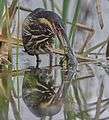Black bittern
The black bittern (Ixobrychus flavicollis) is a bittern of Old World origin, breeding in tropical Asia from Bangladesh, Pakistan, India, and Sri Lanka east to China, Indonesia, and Australia. It is mainly resident, but some northern birds migrate short distances.
| Black bittern | |
|---|---|
.jpg) | |
| Scientific classification | |
| Kingdom: | Animalia |
| Phylum: | Chordata |
| Class: | Aves |
| Order: | Pelecaniformes |
| Family: | Ardeidae |
| Genus: | Ixobrychus |
| Species: | I. flavicollis |
| Binomial name | |
| Ixobrychus flavicollis (Latham, 1790) | |
| Synonyms | |
|
Dupetor flavicollis | |
This is a fairly large species at 58 cm (23 in) in length, being by some margin the largest bittern in the genus Ixobrychus. Compared to related species, it has a longish neck and long yellow bill. The adult is uniformly black above, with yellow neck sides. It is whitish below, heavily streaked with brown. The juvenile is like the adult, but dark brown rather than black.
Their breeding habitat is reed beds. They nest on platforms of reeds in shrubs, or sometimes in trees. Three to five eggs are laid. They can be difficult to see, given their skulking lifestyle and reed bed habitat, but tend to fly fairly frequently when the all black upperparts makes them unmistakable.
Black bitterns feed on insects, fish, and amphibians.
Conservation status
Australia
Black bitterns are not listed as threatened on the Australian Environment Protection and Biodiversity Conservation Act 1999.
State of Victoria, Australia
- The black bittern is listed as threatened on the Victorian Flora and Fauna Guarantee Act (1988).[2] Under this act, an Action Statement for the recovery and future management of this species has not yet been prepared.[3]
- On the 2007 advisory list of threatened vertebrate fauna in Victoria, the black bittern is listed as vulnerable.[4]
Gallery
_in_Kinnarsani_WS%2C_AP_W_IMG_6108.jpg) In Kinnerasani Wildlife Sanctuary, Telangana, India
In Kinnerasani Wildlife Sanctuary, Telangana, India_in_Kinnarsani_WS%2C_AP_W2_IMG_6115.jpg) In Kinnerasani Wildlife Sanctuary, Telangana, India
In Kinnerasani Wildlife Sanctuary, Telangana, India In Kolkata, West Bengal, India
In Kolkata, West Bengal, India In Kolkata, West Bengal, India
In Kolkata, West Bengal, India Black bittern with frog catch at Chilika, Odisha
Black bittern with frog catch at Chilika, Odisha In its natural habitat from wetlands of Ernakuam, Kerala, India
In its natural habitat from wetlands of Ernakuam, Kerala, India
References
- BirdLife International (2012). "Ixobrychus flavicollis". IUCN Red List of Threatened Species. 2012. Retrieved 26 November 2013.CS1 maint: ref=harv (link)
- Department of Sustainability and Environment, Victoria Archived July 18, 2005, at the Wayback Machine
- Department of Sustainability and Environment, Victoria Archived September 11, 2006, at the Wayback Machine
- Victorian Department of Sustainability and Environment (2007). Advisory List of Threatened Vertebrate Fauna in Victoria - 2007. East Melbourne, Victoria: Department of Sustainability and Environment. p. 15. ISBN 978-1-74208-039-0.
- Birds of India by Grimmett, Inskipp and Inskipp, ISBN 0-691-04910-6
